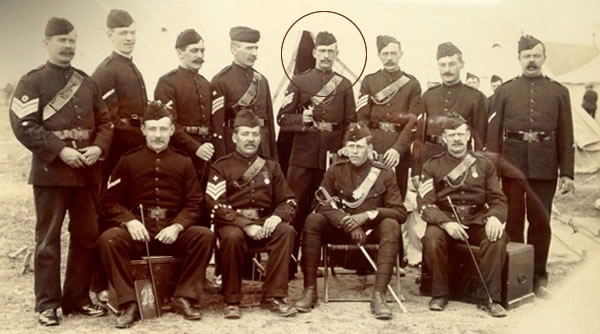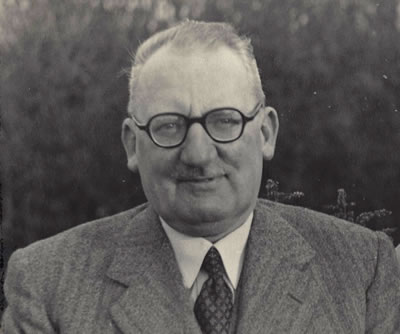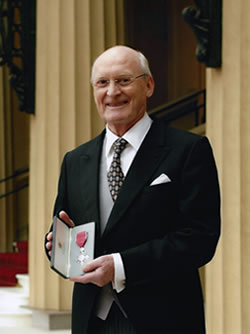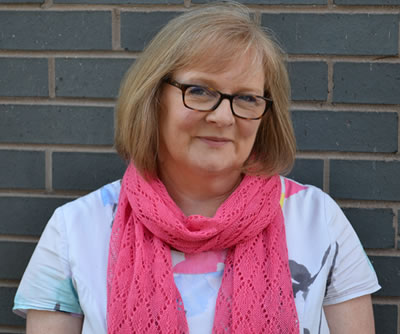A FAMILY AFFAIR
George Henry Hurt (1873 – 1934)

George started his working career at Cooper and Roe, a local hosiery firm. He progressed and became manager at the Midland Shawl & Hosiery Co. in Beeston. As a young man, he also served with the Robin Hood Rifles, (Territorial Army). In 1912, it was a natural step for George to start his own business. Having acquired an old seed mill in Chilwell, (built in 1781), perfect for housing a large number of hand frame knitting machines. With his experience of the knitting industry at that time, George did next what came naturally to him. He brought approximately 10 handframe knitters, together with their handframes, into one location, to create a centralized production unit. Soon after, George invited his son Leslie to work alongside him, and so the family firm G.H.Hurt & Son began and a long tradition of fathers inviting their sons (and daughters) to share in the business. An early customer for the firms fine lacy knitting was the fashion house Jaeger company. G.H.Hurt & Son went on to supply Jaeger for over 75 years. In his later years, George served as a local Councillor and was a lifelong supporter of Nottingham Forest Football Club.
George Leslie Hurt (1898 – 1956)

In 1914, at age 16, Leslie volunteered to join the British Army and enlisted with the Seaforth Highlanders. After turning 17, he was eventually allowed to the Western front and took his part in WWI. Returning home in 1918, aged 20. George Leslie, known as “Les,” shared in the development of his father’s business. During the 1920s and 30’s Leslie also managed the Shetland Wool Co., in Beeston, for a number of years. When his father George passed away, Leslie continued with the family firm. Leslie’s greatest achievement was keeping the family firm going through the 1940s and WWII. With so many restrictions on raw materials and skilled labour, this was perhaps one of the toughest periods in the firm’s history. Many of their fine lacy shawls and scarves were exported, particularly to the USA. So, the business was allowed small exemptions, as the valuable income into the beleaguered British economy was considered important. By the 1940s, G.H.Hurt & Son had built a reputation for exquisite fine lacy knitting. During this period, Harrods began buying their shawls. A keen sportsman, Leslie enjoyed a passion for playing cricket, which he played well into his 50’s. Like his father, he was also a keen supporter of the local football team – Nottingham Forest.
Henry Edward George Hurt MBE (1935 – 2023)

Henry joined his father Leslie at G.H.Hurt & Son from school, aged 18 in 1953, spending the next 6 months apprenticed as a framework knitter, before serving two years National Service with a local Army Regiment, the Sherwood Forester’s. Then, rejoining the family firm in 1955 and learning the business alongside his father. Sadly, Leslie passed away in 1956, leaving young Henry to take the lead. The next 10 year’s proved to be a challenging time for Henry, seeing the traditional handframe knitting business required modernization. During the ’60s and 70s’, Henry made a bold and technically challenging step, converting the traditional lacy patterns from handframes, to specially adapted powered knitting machines. At once revolutionising the business and enabling an increase in production. This allowed the unique and beautiful scarf & shawl designs to be enjoyed by a wider market. For many years, handframe knitting took place alongside modern machine knitting. However, many of the finishing trades were still done by hand. This practice continues until today. 1984 saw the last of the hand frame knitters leave the firm. Jeff Oxley BEM, was age 81 when he eventually retired to his garden plot. (Jeff, Knitter / Mechanic, was awarded a BEM in 1981 for over 60 years services to export) For nearly 20 years, during the 1980s and ’90s, Henry enjoyed considerable success working with the many UK and International retailers and designers. For example, Laura Ashley and John Lewis. In 1989, on the 400th anniversary of the Reverend William Lee inventing the handframe, Henry was invited to join the Worshipful Company of Framework Knitters, (one of the City of London’s Livery Companies) and awarded the freedom of the City of London. In 2009, Henry was rewarded for nearly 60 years of service to the knitting industry in Nottinghamshire. Nominated in the Queen’s Honours list, and awarded an MBE. About the time of the firm's centenary, in 2012, Henry's daughter Gillian was already working alongside her father and in turn, started to take the lead. Through the following years, Henry began to reduce his hours and support Gillian's efforts to innovate and develop the family firm anew. Man and boy, Henry followed the tribulations of Nottingham Forest (now a family tradition) and experienced the privilege of seeing his football team as Football League Champions and European Champions twice.
Gillian Elizabeth Taylor (nee Hurt) (1964 – present)

Gillian is the 4th generation to become involved in the family business. Like Henry, she joined the firm to work with her Father, from school, aged 18, in 1983. During this period, the firm enjoyed a period of stability and success, employing up to 40 staff. However, the 1990s were a challenging time for all British manufacturing and the local knitting industry faced increasing global competition from knitwear suppliers in lower cost economies. Again, G.H.Hurt & Son adapted. With Henry and Gillian focusing on a high quality, design-led approach. Working with designers around the world and innovating with the firms delicate lacy knitting, to create relevant and interesting products. Gillian’s flair for all things colourful & creative, and a keen eye for the latest trend, has added a significant dimension to the business during a time when they work with so many international design houses, including the likes of Burberry, Dior and Paul Smith, to name a few… During the mid 1990s, Gillian had a brief period away from the business to start a family, before returning part-time, then eventually full time again. More recently, during the ’00s and in response to our ever-changing and interconnected digital world, Gillian has developed the firm’s first “own brand” range. The range is an intelligent blend of the firm’s traditional patterns, with a modern twist, relevant for today. She has also launched the company online, with its own branded collection, at www.ghhurt.com. In so doing, making the firm's designs available to a global consumer audience. 2012 was a centenary year for G.H.Hurt & Son, celebrating 100 years of fine lacy knitting. About this time, Gillian started to take the lead, with her father supporting her. Then in 2013, 2015, 2018 and 2019 G.H.Hurt & Son received extraordinarily high levels of interest in their baby shawls and christening shawls, from around the world, following the birth of Prince George, Princess Charlotte, Prince Louis and Baby Archie. All were presented to the world wrapped in one of the firm’s exquisite baby shawls. Their shawls were also used previously by other members of the Royal family.
G.H.Hurt & Son, very much a family firm, continues to evolve with new designs and technical innovations. The future awaits further developments for this small family business, now an established part of the community in Chilwell, Nottingham.
It’s not just the Hurts…. Oxley, Robbins & Others
G.H.Hurt & Son is a family affair, and like hand frame knitting, very much part of the local community, but it’s not just the Hurts. Other local families have contributed to the firm’s development. For example… Frank Oxley was one of the original hand frame knitters that joined the firm, when it was first established in 1912. His frame was used prior to 1912 in Oxley’s Frame Shop in Park Road, Chilwell. Which is just a few steps away from the present Factory. Frank then knitted his hand frame at the firm until 1948. Frank was the father of four sons and two daughters. Two of his son’s Ernest and Harold Oxley also joined the firm and worked a handframe. Ernest was with the firm until 1952 and Harold until 1972. Both of their wives also worked in the firm, employed with finishing trades, such as “pinning out”. Harold was known for his efficient production and could produce around 60 scarves (52” x 20” size) in an 8-hour working day. Ernest and Harold worked with their cousin Jeff Oxley, mentioned earlier. Jeff was the last hand frame knitter, continuing until 1984. More recently, Reginald Robbins is the firms current Head Knitting Mechanic. Having started as an Apprentice Knitting Mechanic, age 16, in 1971. Reg now looks after the various knitting machines, of all ages, handframes to modern computer-operated machines. As G.H.Hurt & Son is now home to a modest history of knitting machinery, spanning approximately 200 - 300 years. At the time Reg joined the firm, his mother Marg and grandmother Vi were already employed with finishing trades. Marg had also been an “out worker” for a period in the late ’50s and ’60s whilst caring for a young family. Taking in work, from the factory, at home. Irene Wilson, (now Reg’s mother-in-Law) joined the firm in 1986 and is still employed on a part-time basis. Irene’s daughter Jayne Wilson came to work at the firm for a period. Jayne met Reg and she became a Robbins! These are just a few of the many families that are part of the firm’s history.
Historically, handframe knitting was always a family affair. At G.H.Hurt & Son, this tradition lives on. Today, modern knitting machinery stands alongside fine examples of handframe knitting machines. G.H.Hurt & Son possess one of the most extensive collections of handframes. Some have been loaned to industrial museums across the UK. A small number are kept in working condition here at the firm’s “Shawl Factory”.